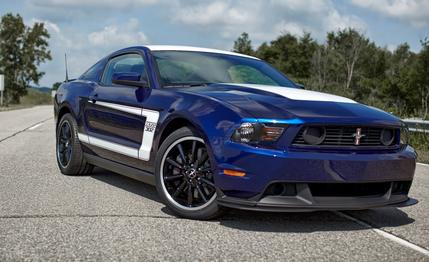
 Instrumented Test
Instrumented Test


Jim Farley, Ford’s group VP of global marketing, didn’t have to fly to California for the debut of the Mustang Boss 302. No one told him to. He came anyway. “I’ve been driving my own Mustang right through the past two Michigan winters thinking about this project,” he says. “From a business standpoint, the Boss 302 shouldn’t have happened. But it happened. My dream for the car was that it would make a lot of money for a guy street racing. It should be a car that winds up on YouTube doing something illegal. I’ve been waiting 20-plus years to launch a car like this.”
The decision to resurrect the Boss 302 was made in the darkest days of the recession. Is Ford brave or what? Especially since it’s so rare that offspring are able to match the feats of legendary forebears, as Charlie Sheen can attest.
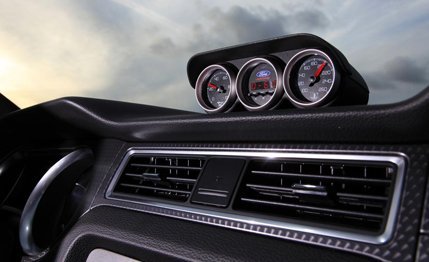

To eke out of the Mustang GT’s engine a bonus 32 horses, Ford created a new intake manifold with runners resembling velocity stacks. Different cylinder heads were deployed—stronger alloy and altered ports—with each head undergoing 2.5 hours of CNC massaging. The camshafts offer increased lift, the intake valves are larger, the bearings are race-spec, and the baffled pan holds 8.5 quarts of synthetic oil.


The result is 444 horsepower at 7500 rpm, a happy medium between the Mustang GT’s 412 horses and the Shelby GT500’s 550. The Boss’s V-8—unlike the brutish Shelby’s—doesn’t so often overwhelm its chassis. In fact, what you first notice—and this is very BMW-ish—is that the Boss’s engine, driveline, and suspension draw virtually no attention to each others’ eccentricities. It lends the package a gratifying sense of unity that inspires confidence.
This V-8 is so vigorous and charismatic that its likeness ought to be carved on Mount Rushmore. The engine revs nearly as quickly as you can flex your right foot, feeling as if it displaces maybe three liters. What’s more, despite all that cam, it idles as smoothly as a Camry.
Sans traction control, launching the Boss takes some practice, although never has practice been so fun. Sidestep the clutch with too many revs, and you’ll trigger axle tramp followed by a cumulous cloud of Pirelli particulates that will only swell in size all the way through second gear. The trick is to slip the clutch from about 3500 rpm, then mat the throttle when the axle says, “Yeah, I’m feelin’ settled and relaxed back here.” The result is 0 to 60 mph in 4.3 seconds—0.3 second quicker than the GT (or a Camaro SS) and only 0.2 second behind the jackhammer GT500. Once that live axle is placated . . . well, here’s the telltale statistic: From 5 to 60 mph, the Boss loses not an inch to the GT500 and is but 0.1 second behind a BMW M3. The accelerative kick flings sunglasses and coins and pens in the center bin backward against a plastic wall, sounding as if they’ve just hit the bottom of a ventilator shaft. Through the quarter-mile, the engine pulls like a Tennessee mule—no valleys, no holes—slingshotting the Boss 0.4 second ahead of the GT and only 1 mph behind the M3.
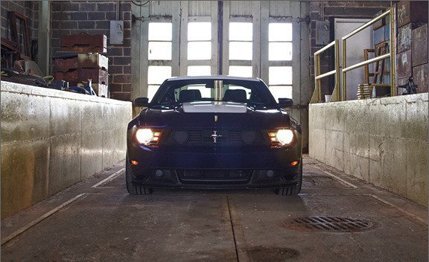

All of this is accompanied by a mellifluous, resonance-free exhaust note that is an unlikely aural confluence of, say, Lexus IS F and Roush/Yates Sprint Cup engine. It’s a four-way exhaust—two sewer pipes astern and one per side exiting just in front of the rear wheels. A restrictor plate in each side pipe lends the Boss federal pass-by legality, but the baffles can be unbolted in less time than it takes to read this review. It’s lucky that the rumble is so rich, because the engine is seriously loud at idle.
The Boss’s suspension has likewise benefited from a lavish labor of love. Compared with the GT, it boasts stiffer springs, a fatter rear stabilizer bar, new bushings, and 19-inch Pirelli P Zeros that, at the rear, are mounted on 9.5-inch-wide wheels. What’s more, each shock offers five settings that are adjustable via screwdriver, creating the possibility of very strange chassis behavior at the hands of very strange owners. Again, is Ford brave or what? And experimenting with dampers is educational, fun, and will make you feel like Parnelli Jones’s crew chief.
The steering rack is electrically assisted and can be toggled to comfort, standard, or sport modes. We preferred the standard setting, even at the track. The other modes did nothing more than alter effort. No matter. The steering was ever accurate, progressive, and informative, with peerless interstate tracking.
At the front, four-pot Brembos clamp 14-inch vented rotors. The pads are near-race-spec compounds, although they don’t squeal, and the brake lines have been hardened to prevent expansion. On the road, pedal feel proved sublime—fairly hard but bang-on linear—and it was a cinch to modulate braking right on the threshold of the ABS. Fade? None that we encountered either during testing or during nine-tenths lapping around Laguna Seca.
As a dance partner in the hills, the Boss eagerly goes all bossa nova, laying down its prodigious power with surprising smoothness. The chassis felt remarkably balanced, usually neutral, leaning toward power oversteer only in the tightest turns. Despite its super-quick transient responses, it never felt nervous. This Mustang is so agile, so responsive to delicate inputs, that it makes the GT500 feel like a FedEx truck. The Boss’s grip almost always exceeds the driver’s courage, so feel free to ignore our lateral-grip figure, recorded on a skidpad dusted with sand. What’s more, the ultra-short-throw shifter was an ally, although its gates are so close that a clumsy upshift from second will sometimes collect fifth.
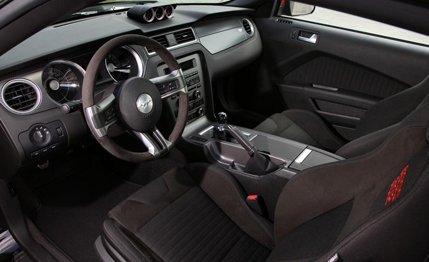

Ford has forever treated its Mustangs as blue-collar contrivances of unprepossessing heritage. The cockpit thus remains dour and rudimentary, despite the synthetic-suede-wrapped steering wheel and the machine-turned aluminum trim. The acres of coarse, pebbled-plastic surfaces, in particular, would be (and have been) rejected in far less expensive machines, notably in Ford’s own Focus. The gaping voids between the tops of the rear tires and the rolled fender lips are eyesores. The steering column doesn’t telescope. And the brake and accelerator pedals should be closer together.
The base Boss fetches $40,995, and there is only one major option: a Torsen limited-slip differential and Recaro seats (packaged together and costing $1995), plus the so-called TracKey. If you’re headed for the track—and why wouldn’t you be?—then all three are mandatory. In total, 4000 examples will be assembled, which isn’t even half of the original Boss’s two-year production. That sum includes 3250 base Bosses and 750 Laguna Seca editions.
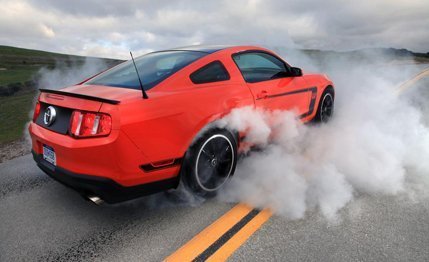

We expected the Boss 302 to be little more than a marketing exercise in nostalgia, a somewhat more brutal, slightly faster GT, with alluring graphics but primitive predilections. It isn’t. Nose to tail, this feels like a whole new equine—thoroughly sorted, conscientiously massaged, the object of considerable forethought and ambition. As automotive resurrections go, this is a knockout that venerates the original Boss while embarrassing it objectively and subjectively in every meaningful measure. What this is, is the best Mustang ever.